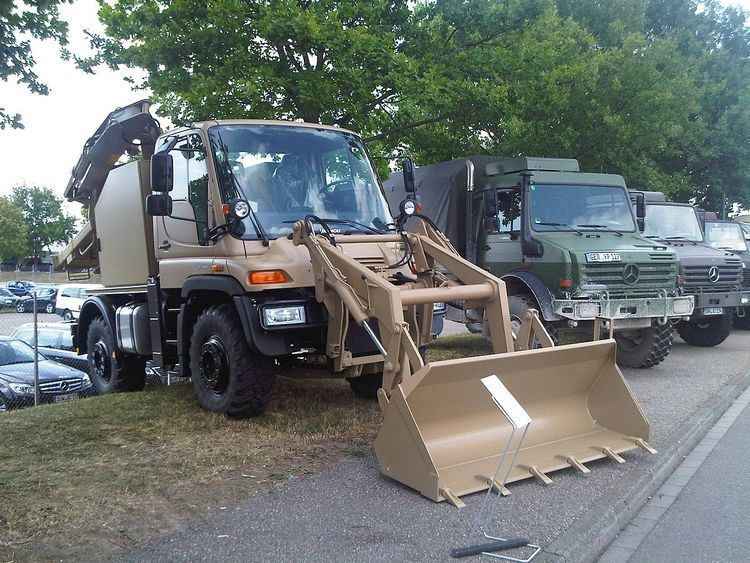 | ||
A backhoe loader, also called a loader backhoe, digger in layman's terms, or colloquially shortened to backhoe within the industry, is a heavy equipment vehicle that consists of a tractor like unit fitted with a loader-style shovel/bucket on the front and a backhoe on the back. Due to its (relatively) small size and versatility, backhoe loaders are very common in urban engineering and small construction projects (such as building a small house, fixing urban roads, etc.) as well as developing countries. This type of machine is similar to and derived from what is now known as a TLB (Tractor-Loader-Backhoe), which is to say, an agricultural tractor fitted with a front loader and rear backhoe attachment.
Contents
The true development of the backhoe actually began in 1947 by the inventors that started the Wain-Roy Corporation of Hubbardston, Massachusetts. In 1947 Wain-Roy Corporation developed and tested the first actual backhoes. In April 1948 Wain-Roy Corporation sold the very first all hydraulic backhoes, mounted to a Ford Model 8N tractor, to the Connecticut Light and Power Company for the sum of $705.
History
Evolving in parallel to development in the U.S., backhoes were first produced in the UK in 1953 by JCB. Although based on a tractor, a backhoe loader was and is almost never called a tractor when both the loader and the backhoe are permanently attached. Backhoe loaders are also not generally used for towing and usually do not have a power take-off (PTO) as often this is used to drive the hydraulic pump operating the attachments. When the backhoe is permanently attached, the machine usually has a seat that can swivel to the rear to face the hoe controls. Removable backhoe attachments almost always have a separate seat on the attachment itself.
In Britain, Ireland and India they are commonly referred to simply as JCBs due to the company being the first manufacturer in the UK and major supplier. In the United States, they are often referred to as "backhoes", although the term 'backhoe' only refers to one component. In Russia they are referred as excavator - loader
In 1970, Hy-Dynamic now a division of Bucyrus-Erie, manufacturer of the Dynahoe was the first company to incorporate a four wheel drive system into their backhoe loaders, allowing these models to go over almost any terrain with little difficulty. Since the backhoe was invented, several companies such as Caterpillar and John Deere have changed the backhoe's back arm to be slightly curved as per an excavator, which can allow more maneuverability.
Use
Backhoe loaders are very common and can be used for a wide variety of tasks: construction, small demolitions, light transportation of building materials, powering building equipment, digging holes/excavation, landscaping, breaking asphalt, and paving roads. Often, the backhoe bucket can also be replaced with powered attachments such as a breaker, grapple, auger, or a stump grinder. Enhanced articulation of attachments can be achieved with intermediate attachments such as the tiltrotator. Many backhoes feature quick coupler (quick-attach) mounting systems and auxiliary hydraulic circuits for simplified attachment mounting, increasing the machine's utilization on the job site. Some loader buckets have a retractable bottom or "clamshell", enabling it to empty its load more quickly and efficiently. Retractable-bottom loader buckets are also often used for grading and scraping. The front assembly may be a removable attachment or permanently mounted.
Because digging while on tires intrinsically causes the machine to rock, and the swinging weight of the backhoe could cause the vehicle to tip, most backhoe loaders use hydraulic outriggers or stabilizers at the rear when digging and lower the loader bucket for additional stability. This means that the bucket must be raised and the outriggers retracted when the vehicle needs to change positions, reducing efficiency. For this reason many companies offer miniature tracked excavators, which sacrifice the loader function and ability to be driven from site to site, for increased digging efficiency.
Their relatively small frame and precise control make backhoe-loaders very useful and common in urban engineering projects such as construction and repairs in areas too small for larger equipment. Their versatility and compact size makes them one of the most popular urban construction vehicles. For larger projects, a tracked excavator is generally used.
In recent years, small compact tractors from manufacturers such as Kubota have become very popular with private homeowners. Subcompact tractors, the size between a compact tractor and lawn tractor, are also often sold in backhoe loader setup, sometimes with a belly-mounted mower also included. These tractors offer private homeowners the ability to perform minor excavation projects.
